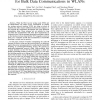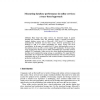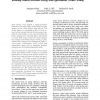190 search results - page 12 / 38 » Using non-volatile memory to save energy in servers |
ICNP
2007
IEEE
14 years 1 months ago
2007
IEEE
— While the 802.11 power saving mode (PSM) and its enhancements can reduce power consumption by putting the wireless network interface (WNI) into sleep as much as possible, they ...
TPCTC
2009
Springer
14 years 1 months ago
2009
Springer
Many large-scale online services use structured storage to persist metadata and sometimes data. The structured storage is typically provided by standard database servers such as Mi...
VLSID
2004
IEEE
14 years 7 months ago
2004
IEEE
Power consumption has become a major design limiter. With the continued reduction of threshold voltages, optimizing leakage energy consumption is becoming increasingly important. ...
ICCD
2005
IEEE
14 years 4 months ago
2005
IEEE
Main memory has become one of the largest contributors to overall energy consumption and offers many opportunities for power/energy reduction. In this paper, we propose a PowerAw...
ISCA
2012
IEEE
11 years 9 months ago
2012
IEEE
Most modern cores perform a highly-associative translation look aside buffer (TLB) lookup on every memory access. These designs often hide the TLB lookup latency by overlapping it...



